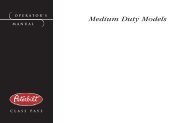Peterbilt Medium Duty Truck Owner's Manual - Peterbilt Motors
Peterbilt Medium Duty Truck Owner's Manual - Peterbilt Motors
Peterbilt Medium Duty Truck Owner's Manual - Peterbilt Motors
Create successful ePaper yourself
Turn your PDF publications into a flip-book with our unique Google optimized e-Paper software.
STARTING AND OPERATING THE VEHICLE<br />
3. Drain water from the air reservoirs.<br />
• While the engine and air supply system are still<br />
warm, drain moisture from the air reservoirs. Open<br />
the reservoir drains just enough to drain the moisture.<br />
Do not deplete the entire air supply. Be sure to<br />
close the drains before leaving the vehicle.<br />
4. Secure the vehicle, close all the windows, and lock all<br />
doors.<br />
Before Stopping the Engine<br />
Do not shut off the engine immediately. A hot engine<br />
stores a great amount of heat and it does not cool down<br />
immediately after you shut if off. Always cool the engine<br />
down before shutting it off. You will greatly increase its service<br />
life.<br />
Idle the engine at 1000 rpm for five minutes. Then low idle<br />
for thirty seconds before shutdown. This will allow circulating<br />
coolant and lubricating oil to carry away heat from the<br />
cylinder head, valves, pistons, cylinder liners, turbocharger,<br />
and bearings. This way you can prevent engine<br />
damage that may result from uneven cooling.<br />
SHUT–DOWN<br />
Turbocharger<br />
This cooling-down practice is especially important for a<br />
turbocharged engine. The turbocharger on your vehicle<br />
contains bearings and seals that are subjected to hot<br />
exhaust gases. While the engine is operating, heat is carried<br />
away by circulating oil. If you stop the engine suddenly<br />
after a hard run, the temperature of the<br />
turbocharger could rise to as much as 100°F (55°C)<br />
above the temperature reached during operation. A sudden<br />
rise in temperature like this could cause the bearings<br />
to seize or the oil seals to loosen.<br />
Refueling<br />
Air inside the fuel tanks allows water to condense in the<br />
tank. To prevent this condensation while the vehicle is<br />
parked for extended periods of time, fill the tanks to 95<br />
percent of capacity. Never fill to more than 95 percent<br />
capacity as this provides room for expansion resulting<br />
from temperature extremes. When refueling, add approximately<br />
the same amount to each fuel tank on vehicles<br />
with more than one tank.<br />
<strong>Medium</strong> <strong>Duty</strong> (R05/09) Y53-6027 – 147 –
















